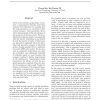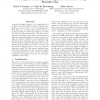310 search results - page 30 / 62 » MuFeSaC: Learning When to Use Which Feature Detector |
JMLR
2010
13 years 3 months ago
2010
Given several related learning tasks, we propose a nonparametric Bayesian model that captures task relatedness by assuming that the task parameters (i.e., predictors) share a late...
ECCV
2006
Springer
14 years 11 months ago
2006
Springer
Abstract. In this paper we investigate a new method of learning partbased models for visual object recognition, from training data that only provides information about class member...
ECAI
1994
Springer
14 years 1 months ago
1994
Springer
1 We develop a learning component for a theorem prover designed for verifying statements by mathematical induction. If the prover has found a proof, it is analyzed yielding a so-ca...
ICCV
2011
IEEE
12 years 9 months ago
2011
IEEE
We describe a directed bilinear model that learns higherorder groupings among features of natural images. The model represents images in terms of two sets of latent variables: one...
ANLP
2000
13 years 10 months ago
2000
In spoken dialogue systems, it is important for a system to know how likely a speech recognition hypothesis is to be correct, so it can reprompt for fresh input, or, in cases wher...


